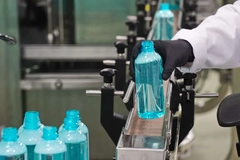Packaging Analysis Improves Design
05 Jul 2011

Tetra Pak is a food processing and packaging company that pioneered aseptic processing methods in the 1960s. It involves the ultra-high-temperature (UHT) treatment of milk and other liquid foods so that they are kept safe, fresh, and flavorful for at least six months without refrigeration.
Tetra Pak is a food processing and packaging company that pioneered aseptic processing methods in the 1960s. It involves the ultra-high-temperature (UHT) treatment of milk and other liquid foods so that they are kept safe, fresh, and flavorful for at least six months without refrigeration.
By all outward appearances, these packages appear simple, but the process for making them are complex and sometimes they run into trouble with forming and folding. First, a continuous reel of carton-based packing material – a paper composite strengthened with ultra-thin layers of plastic and aluminum – is fed into a filling machine and sterilized. The material is formed and sealed into a tube and filled, causing it to expand. It is then formed into shape and sealed to keep it sterile. Last, it is cut into individual packages.
But the next step can present some problems: Gravity drives the liquid down, however, the folding step and the resulting tube deformation force the liquid backward. A pressure flange reduces the amount of backflow but the tube can still deform. It needs to retain its structural integrity without breaking or crimping.
According to Dr. Mattias Olsson, Tetra Pak manager of virtual engineering, “When designing new packaging or when modifying the filling machine, folding and forming are critical maneuvers. In the past, they have been difficult to predict.”
Olsson added, “We needed a realistic, reliable simulation method that took into account the liquid, packaging material, and all the major forces acting and interacting on them.”
The company implemented Abaqus FEA software from Dassault Systemes’ Simulia subsidiary. For their initial trial analysis, the engineers selected the Tetra Fino Aseptic 500 ml milk package. The material was very thin and flexible which made for large deformation under pressure changes. The cross-section of the tube rapidly changed from a circular cross-section to fully closed when folded. Also, there was a strong fluid-structure interaction to be modeled that had to take into account the changing pressure waves in the fluid and their effects on the packaging material.
The model for analysis included the following:
- The composite packaging
- The packaged fluid including its flow and pressure properties
- The flotation device that rests on top of the fluid surface
- The system that folds the packaging material
- The pressure flange that controls pressure waves inside the tube
Structural items were modeled in a “Lagrangian” framework. The flexible packaging material was modeled with shell elements calibrated to represent the laminated material as though it were homogenous which reduced the computation time for the analysis. The fluid was modeled using an “Eulerian” approach that accurately captured the characteristics of non-viscous fluid flow.
The combination of methods helped the engineers model the interaction of the packaging tube and the fluid in a single analysis. Because the packaging process is axially symmetric, the engineers modeled one-half of the system to substantially reduce processing time. The model involved approximately 220,000 elements with about 700,000 variables.
Engineers were able to model and define a variety of design parameters including:
- Sequencing the folding system action, including the deformation of the material
- Determining the choice and suitability of the packaging material
- Establishing the correlation between fluid injection rate and formed packaging volume
- Defining the tensile load applied to the material so as to prevent breakage or crimping
Source: Tetra Pak
All content and features on this website are copyrighted with all rights reserved. The full details can be found in our privacy statement
Subscribe to our newsletters
By continuing to browse our site you agree to our Privacy Statement











